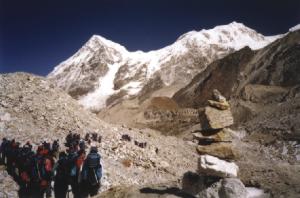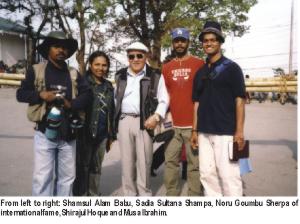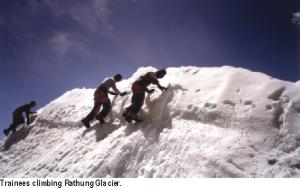High Ambition
The Would-be
Mountaineers of Bangladesh
Mustafa
Zaman
The news
of a group of young trekkers getting ready to give a shot at
climbing Mount Everest may result in mixed reactions. As a people
of low-altitude alluvial plain, many Bangladeshis might consider
mountaineering to be too ambitious an undertaking. But as the
first group that came back from a month long basic course in
mountaineering, it can be surmised that, with the right amount
of drive coupled with perseverance, anything can be accomplished.
 As
the trainees articulate their dream and the hardship suffered
in the Himalayan Mountaineering Institute in Darjeeling, they
reveal an ambition gelled by the thought that no Bangali ever
made it to the highest summit. They would like to change that.
The four who came back after receiving basic training are unanimous
on this point. The goal has been set, now all that is needed
is perseverance to train themselves for the next five years,
the calculated space of time of preparation in the run up to
the first attempt.
As
the trainees articulate their dream and the hardship suffered
in the Himalayan Mountaineering Institute in Darjeeling, they
reveal an ambition gelled by the thought that no Bangali ever
made it to the highest summit. They would like to change that.
The four who came back after receiving basic training are unanimous
on this point. The goal has been set, now all that is needed
is perseverance to train themselves for the next five years,
the calculated space of time of preparation in the run up to
the first attempt.
It was in
last September that Shamsul Alam Babu, Sadia Sultana Shampa,
Musa Ibrahim and Shirajul Haque joined the Everest Team-1. Two
groups, one of the seniors and the other consisting of the college-going
enthusiasts, who would train for mountaineering, was formed
with Enam Ul Haque, the only Bangladeshi to have travelled to
the Antarctica, as the convener. From that group, six members
took the first step to educate themselves. Among those six members
of the senior group, four joined the March session and came
back with their resolve multiplied.
 These
four have their different occupations to pursue. The only female
member of the team is a student of geography at Jagannath University
College. She is Sadia Sultana Shampa, whose passion for mountaineering
has set many a male eyebrow skyward. Though one would be in
danger of painting a generalised picture of the male psyche
if the reactions of the males are overemphasised, it is true
that Bangladesh still remains at the throe of a traditional
view that sees women in fixed roles. As for the men in the team,
they are struggling to strike a balance between their jobs and
the newly acquired passion. Among them, Shamsul Alam Babu is
a freelance photographer, Musa Ibrahim is a feature contributor
to the Daily Prothom Alo, and Sirajul Haque Sagar is
an architect.
These
four have their different occupations to pursue. The only female
member of the team is a student of geography at Jagannath University
College. She is Sadia Sultana Shampa, whose passion for mountaineering
has set many a male eyebrow skyward. Though one would be in
danger of painting a generalised picture of the male psyche
if the reactions of the males are overemphasised, it is true
that Bangladesh still remains at the throe of a traditional
view that sees women in fixed roles. As for the men in the team,
they are struggling to strike a balance between their jobs and
the newly acquired passion. Among them, Shamsul Alam Babu is
a freelance photographer, Musa Ibrahim is a feature contributor
to the Daily Prothom Alo, and Sirajul Haque Sagar is
an architect.
"It
all started from the meetings we used to have every third Wednesday
of each month in Enam Ul Haque's house. As trekkers we used
to set our programmes and modalities in these gatherings,"
says Shamsul who belongs to the Bangla Mountaineers and Trekkers
Club of Azimpur. "The idea of forming a group that would
prepare for Everest climbing came to Enam bhai," adds Musa.
It was in
2003, when two of the members of the Bangla Mountaineers and
Trekkers Club, Rifat Hassan and Muntasir Mamun, came back from
Nepal after attending the 50th anniversary of the first summit
by Edmond Hillary and Tenjing Norgay Sherpa, that Inam Ul Haque
decided to form the mountaineers groups. "The two visiting
members came back with a load of photographs, and it was at
their exhibition at Drik gallery on September 9, 2003 that the
decision to form groups of mountaineers was finalised,"
Shamsul
let us know. They were all harping on the one and only idea:
"being so close to the Himalayas, no Bangladeshi ever felt
the urge to conquer the world's tallest summit". The Bangladesh
Everest Team-1 that was formed last September under the supervision
of Enam has embarked on a mission to change that history. If
they fail to succeed, at least they would leave back a history
of attempts for others to fall back upon.
Shamsul
harks back to history, "Radhanath Sikder was the Bangali
who discovered the height of Everest; he was working as the
surveyor general under George Everest. But it's a pity that
Bangalis failed to follow up this act". It was Muntasir's
unending enthusiasm that made him privy to the mountaineering
related information. "He culled the addresses of the institutions
in India for us," says Shamsul.
The institute
crowns the Jayal Parbat in Darjeeling. At 7,000 feet altitude,
it mostly facilitates the Indian defense personnel, but it takes
in general public too, though with a higher fee. For foreigners
it is 500 dollars, though for Bangladeshi enthusiasts it was
cut down to 200.
The expeditions
of these trekkers turned mountaineers are being sponsored by
Mountain Dew, a concern of Transom Ltd. "At the initial
stage we had to spend from our personal coffer. I went to extract
information on admission in last November on my own," Shamsul
says. By that time Mountain Dew has become their partner in
this endeavour.
The quartet's
firmness in pursuing their goal is a much-needed quality. The
basic course was the first hurdle that they had to go through.
"The course calls for extreme physical activities in extreme
conditions. Every day was a blight of sorts, but we were determined
not to give up," says Shirajul.
Musa's affinity
with the mountain began at an early stage. "My childhood
was spent in Panchagar, from where the Kanchanjangha is visible.
I spent days savouring the natural splendour by bunking school,"
Musa relates. His childhood played a part in catalysing his
ambition.
He
contributes travel pieces to Prothom Alo. "If
I were a regular staff, I would not have been able to have the
time to travel or trek the way I do," says Musa, who is
all bucked up to go to Nepal to trek the trail leading to the
'base camp' in the Himalayas which is at altitude an of 18,500
feet.
 Shirajul,
on the other hand, works at a job that seems incongruous with
his passion for climbing. As an architect of Concord Real State,
he is torn between his job and his passion. It takes a lot to
convince his superiors and colleagues the purpose of his yearly
excursions that take him away from his workplace for many days.
He is convinced that a study tour to India as a student of Khulna
University triggered his zeal. "Now after returning from
trekking, many ask how it was on the Everest, they simply don't
have any idea of how long it takes even to prepare for the Everest
climbing," adds Shirajul.
Shirajul,
on the other hand, works at a job that seems incongruous with
his passion for climbing. As an architect of Concord Real State,
he is torn between his job and his passion. It takes a lot to
convince his superiors and colleagues the purpose of his yearly
excursions that take him away from his workplace for many days.
He is convinced that a study tour to India as a student of Khulna
University triggered his zeal. "Now after returning from
trekking, many ask how it was on the Everest, they simply don't
have any idea of how long it takes even to prepare for the Everest
climbing," adds Shirajul.
The first
rule laid down by the Nepal Mountaineering Association is that
each climber must prove to have successfully accomplished a
summit at 2,000 feet altitude first. It is only after this that
a mountaineer may receive the green light to climb the highest
summit.
Living in
Dhaka means living almost at the level of the sea, as it is
only at an altitude of 35 feet. Mountaineers from this region
certainly have few hills to climb. But these four think otherwise.
They believe that there are peaks and ridges that represent
years of training possibilities. "Even rock climbing can
be practiced in the hilly district," says Shamsul.
Like all
the other fellow trekkers, Sadia too had to go through the trail
that led to the summit of Keokaradong. All of them were trained
under SG Kibria Dipu and after conquering Bangladesh's highest
peak, were ready for the professional courses.
Sadia inspires
either awe or derision from a cross section of people. "My
mother, maternal uncle and grandmother were supportive, otherwise
many still think that mountaineering is not for women,"
Sadia says, who while disembarking from the bus at dawn during
their return trip from Darjeeling surprised many as she was
carrying her huge rucksack on her back. Sadia let us know that
among 55 trainees at the institute, there were only eight female
aspirants, and among them seven were Indians.
These four
are now waiting to get enrolled in the next advanced session,
the only thing that stand in their way is the reluctance of
the Indian High Commission in issuing the visas. The other group
-- the Mountain Dew Extreme Team -- is now in Darjeeling. It
headed for Darjeeling a couple of weeks back. The Everest seems
to be turning many young people towards taking mountaineering
as a serious sport. Sadia sums it up well by saying, "I
started with the ambition to conquer the Everest, but now I
feel that I will try and be a mountaineer first."

 As
the trainees articulate their dream and the hardship suffered
in the Himalayan Mountaineering Institute in Darjeeling, they
reveal an ambition gelled by the thought that no Bangali ever
made it to the highest summit. They would like to change that.
The four who came back after receiving basic training are unanimous
on this point. The goal has been set, now all that is needed
is perseverance to train themselves for the next five years,
the calculated space of time of preparation in the run up to
the first attempt.
As
the trainees articulate their dream and the hardship suffered
in the Himalayan Mountaineering Institute in Darjeeling, they
reveal an ambition gelled by the thought that no Bangali ever
made it to the highest summit. They would like to change that.
The four who came back after receiving basic training are unanimous
on this point. The goal has been set, now all that is needed
is perseverance to train themselves for the next five years,
the calculated space of time of preparation in the run up to
the first attempt.  These
four have their different occupations to pursue. The only female
member of the team is a student of geography at Jagannath University
College. She is Sadia Sultana Shampa, whose passion for mountaineering
has set many a male eyebrow skyward. Though one would be in
danger of painting a generalised picture of the male psyche
if the reactions of the males are overemphasised, it is true
that Bangladesh still remains at the throe of a traditional
view that sees women in fixed roles. As for the men in the team,
they are struggling to strike a balance between their jobs and
the newly acquired passion. Among them, Shamsul Alam Babu is
a freelance photographer, Musa Ibrahim is a feature contributor
to the Daily Prothom Alo, and Sirajul Haque Sagar is
an architect.
These
four have their different occupations to pursue. The only female
member of the team is a student of geography at Jagannath University
College. She is Sadia Sultana Shampa, whose passion for mountaineering
has set many a male eyebrow skyward. Though one would be in
danger of painting a generalised picture of the male psyche
if the reactions of the males are overemphasised, it is true
that Bangladesh still remains at the throe of a traditional
view that sees women in fixed roles. As for the men in the team,
they are struggling to strike a balance between their jobs and
the newly acquired passion. Among them, Shamsul Alam Babu is
a freelance photographer, Musa Ibrahim is a feature contributor
to the Daily Prothom Alo, and Sirajul Haque Sagar is
an architect. Shirajul,
on the other hand, works at a job that seems incongruous with
his passion for climbing. As an architect of Concord Real State,
he is torn between his job and his passion. It takes a lot to
convince his superiors and colleagues the purpose of his yearly
excursions that take him away from his workplace for many days.
He is convinced that a study tour to India as a student of Khulna
University triggered his zeal. "Now after returning from
trekking, many ask how it was on the Everest, they simply don't
have any idea of how long it takes even to prepare for the Everest
climbing," adds Shirajul.
Shirajul,
on the other hand, works at a job that seems incongruous with
his passion for climbing. As an architect of Concord Real State,
he is torn between his job and his passion. It takes a lot to
convince his superiors and colleagues the purpose of his yearly
excursions that take him away from his workplace for many days.
He is convinced that a study tour to India as a student of Khulna
University triggered his zeal. "Now after returning from
trekking, many ask how it was on the Everest, they simply don't
have any idea of how long it takes even to prepare for the Everest
climbing," adds Shirajul.